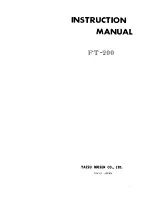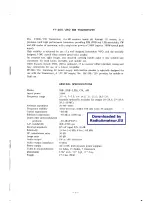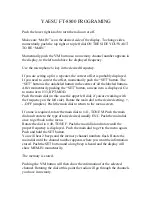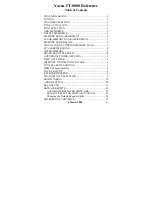
8
REAR PANEL CONNECTIONS
Rear Panel Connections
8-Channel Direct Inputs:
These jacks are
used for connection to source devices such as
DVD-Audio or SACD players with discrete analog
outputs. Depending on the source device in use,
all eight jacks may be used, though in many
cases only connections to the front left/right,
center, surround left/right and LFE (subwoofer
input) jacks will be used for standard 5.1 audio
signals.
Digital Audio Outputs:
Connect these
jacks to the matching digital input connector on
a digital recorder such as a CD-R or MiniDisc
recorder.
Video Monitor Outputs:
Connect this jack
to the composite and/or S-Video input of a TV
monitor or video projector to view the on-screen
menus and the output of any standard Video or
S-Video source selected by the receiver’s video
switcher.
DVD Video Inputs:
Connect these jacks to
the composite or S-Video output jacks on a DVD
player or other video source.
Front Speaker Outputs:
Connect these
outputs to the ma or – terminals on your
left and right speakers. In conformance with the
new CEA color code specification, the White ter-
minal is the positive, or "+" terminal that should
be connected to the red (+) terminal on Front
Left speaker with the older color coding, while
the Red terminal is the positive, or "+" terminal
that should be connected to the red (+) terminal
on Front Right speaker. Connect the black (–) ter-
minals on the AVR to the black (–) terminals on
the speakers. See page 16 for more information
on speaker polarity.
Center Speaker Outputs:
Connect these
outputs to the ma and – terminals on
your center channel speaker. In conformance with
the new CEA color code specification, the Green
Terminal is the positive, or "+" terminal that
should be connected to the red (+) terminal on
speakers with the older color coding. Connect
the black (–) terminal on the AVR to the black
negative (–) terminal on your speaker. (See page
16 for more information on speaker polarity.)
Surround Speaker Outputs:
Connect
these outputs to the ma and – terminals
on your surround channel speakers. In confor-
mance with the new CEA color code specifica-
tion, the Blue terminal is the positive, or "+" ter-
minal that should be connected to the red (+)
terminal on the Surround Left speaker with older
color coding, while the Gray terminal should be
connected to the red (+) terminal on the
Surround Right speaker with the older color cod-
ing. Connect the black (–) terminal on the AVR to
the matching black negative (–) terminals for
each surround speaker. (See page 16 for more
information on speaker polarity.)
Switched AC Accessory Outlet:
This outlet
may be used to power any device that you wish
to have turn on when the AVR is turned on with
the
System Power Control
switch
2
.
USB Connector:
Connect a cable with a
USB “Mini B” connector to the AVR and the
other end to a compatible computer running
Windows
®
2000, Windows
®
XP or higher with
the latest service packs installed, to use this port
to listen to audio from the computer through the
AVR 645. This connection is also used to connect
a compatible computer to the AVR for firmware
upgrades, when available. See page 43 for more
information on playback of computer audio with
the AVR. Instructions for upgrades will accompa-
ny the upgrade file download package.
AC Power Cord Jack:
Connect the AC
power cord to this jack when the installation is
complete. To ensure safe operation, use only the
power cord supplied with the unit. If a replace-
ment is required it must be of the same type and
capacity.
Component Video 2 Inputs:
These inputs
may be used with any video source device
equipped with analog Y/Pr/Pb or RGB component
video outputs. The factory default is for these
jacks to be a linked to the Video 2 input, but you
may change the setting at any time through the
IN/OUT SETUP
menu. See page 16 for
more information on configuring the component
video inputs.
Monitor Component Video Outputs:
Connect these outputs to the component video
inputs of a video projector or monitor. When a
source connected to one of the two
Component Video Inputs
is selected the
signal will be sent to these jacks.
Component Video 1 Inputs:
These inputs
may be used with any source device equipped
with analog Y/Pr/Pb or RGB component video
outputs. The factory default is for these jacks to
be a linked to the Video 1 input, but you may
change the setting at any time through the
IN/OUT SETUP
menu. See page 16 for
more information on configuring the component
video inputs.
Note:
All component inputs/outputs can be used
for RGB signals too, in the same way as
described for the Y/Pr/Pb signals, then connected
to the jacks with the corresponding color.
RGB connection is not possible if the source out-
puts a separate sync signal (see page 17).
Remote IR Output:
This connection permits
the IR sensor in the receiver to serve other
remote controlled devices. Connect this jack to
the “IR IN” jack on Harman Kardon or other
compatible equipment.
Remote IR Input:
If the AVR’s front-panel
IR sensor is blocked due to cabinet doors or
other obstructions, an external IR sensor may be
used. Connect the output of the sensor to this
jack.
Multiroom IR Input:
Connect the output of an
IR sensor in a remote room to this jack to operate
the AVR’s multiroom control system.
Video 1 Video Outputs:
Connect these
jacks to the
RECORD/INPUT
composite or
S-Video jack on a VCR.
Video 1 Video Inputs:
Connect these jacks
to the
PLAY/OUT
composite or S-Video jacks on
a VCR or other video source.
HDMI Output:
Connect this jack to the
HDMI input on a compatible HDMI-equipped
video display.
Video 3 Video Inputs:
Connect these jacks
to the
PLAY/OUT
composite or S-Video jacks on
any video source.
!
Video 2 Video Inputs:
Connect these jacks
to the
PLAY/OUT
composite or S-Video jacks on
a second VCR or other video source.
Optical Digital Inputs:
Connect the
optical digital output from a DVD player, HDTV
receiver, LD player, MD player or CD player to
these jacks. The signal may be either a Dolby
Digital signal, a DTS signal, a 2 channel MPEG 1
signal, an HDCD data stream or a standard PCM
digital source.
29851_AVR645_ENG 30/10/06 9:46 Side 8









































